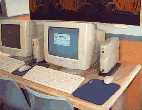Thin Clients go to School
 According to Gene the ThinLinx thin client computers can boot from a flash memory card or a USB drive and can run a web browser locally. So these could be used for low cost web terminals in cyber cafes and the like, for POS and digital signs.
According to Gene the ThinLinx thin client computers can boot from a flash memory card or a USB drive and can run a web browser locally. So these could be used for low cost web terminals in cyber cafes and the like, for POS and digital signs.This reminded me that I had talked on ABC Radio in Canberra about a "Thin Client" computer system installed at Palmerston District Primary School in 2002. The school was using Citrix for providing Microsoft Windows applications. I saw much the same technology a few years before on a classified military systems at the Australian Defence Department
At the time the school had 200 desktop units for 464 students: 100 PCs and 100 thin clients: 100 NCD Thin Clients, 3 IBM application servers, FISC CD Cache, IBM Domain controller / File server, UPS.
The thin client machines were expected to last six years, with upgrades needed to the servers in about three years. Some old PCs were recycled by adding client software. The servers ran Windows 2000 Advanced Server and Terminal Services. The teacher and other staff had PCs on a separate network, with a firewall between the systems to keep the students out of the administrative system. Students were using Microsoft applications.
As I said in 2002, Labtam, based in Melbourne, produced advanced thin client workstations (then called "X terminals") in 1989. These were sold to organisations such as the Australian Department of Defence and ANU. However, it was difficult for Labtam to convince Australian buyers that an Australian product could be so good and at that stage ordinary office automation products did not run on the terminals. The X-terminal hardware business was sold to Tektronix Inc.
Perhaps the new Linux thin clients will provide a new opportunity for Australian industry and help the Australian economy. Even if the thin client hardware is imported, it could help the Australian balance of trade if it displaces much more expensive imported PCs. Also the use of free open source software will reduce the need to pay software license fees to overseas companies. There is the opportunity for locally developed software for the units, as well as for local companies to install and configure the software.
Apart from saving energy, the low power consumption of the thin client machines might be useful in mission critical applications. A far smaller UPS would be needed to keep a network of thin client machines running, than conventional PCs. If carefully designed, it may be cost effective to power the UPS from renewable sources, such as solar panels or wind power. If this low power consumption also helps the environment, with the thin clients using less power, that is a bonus.
Labels: Citrix, environment, Thin Client Computing


0 Comments:
Post a Comment
Links to this post:
Create a Link or bookmark with Digg, del.icio.us, Newsvine or News Feed
<< Home